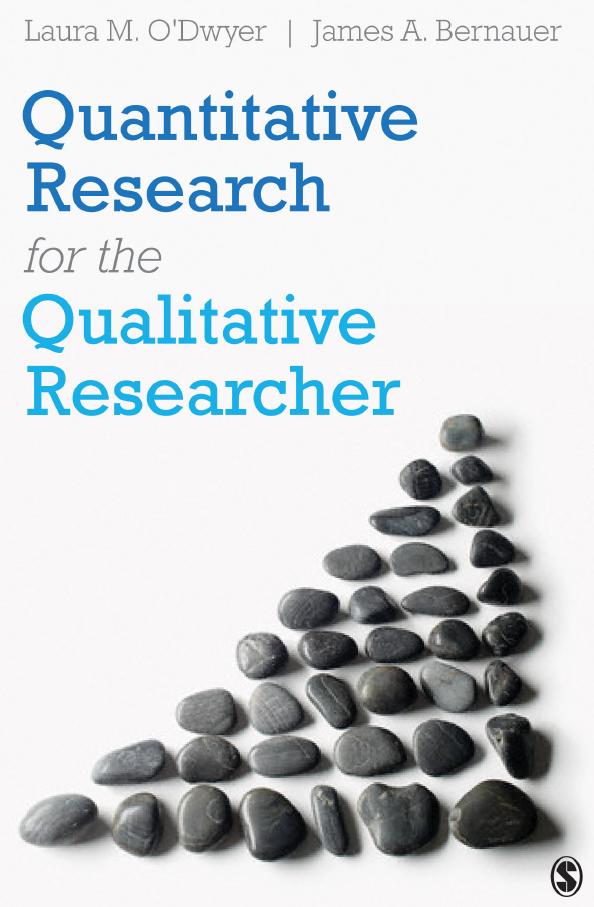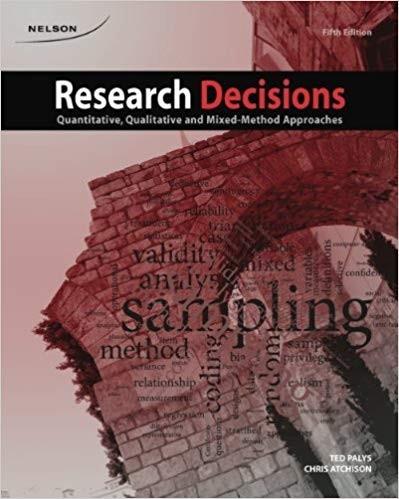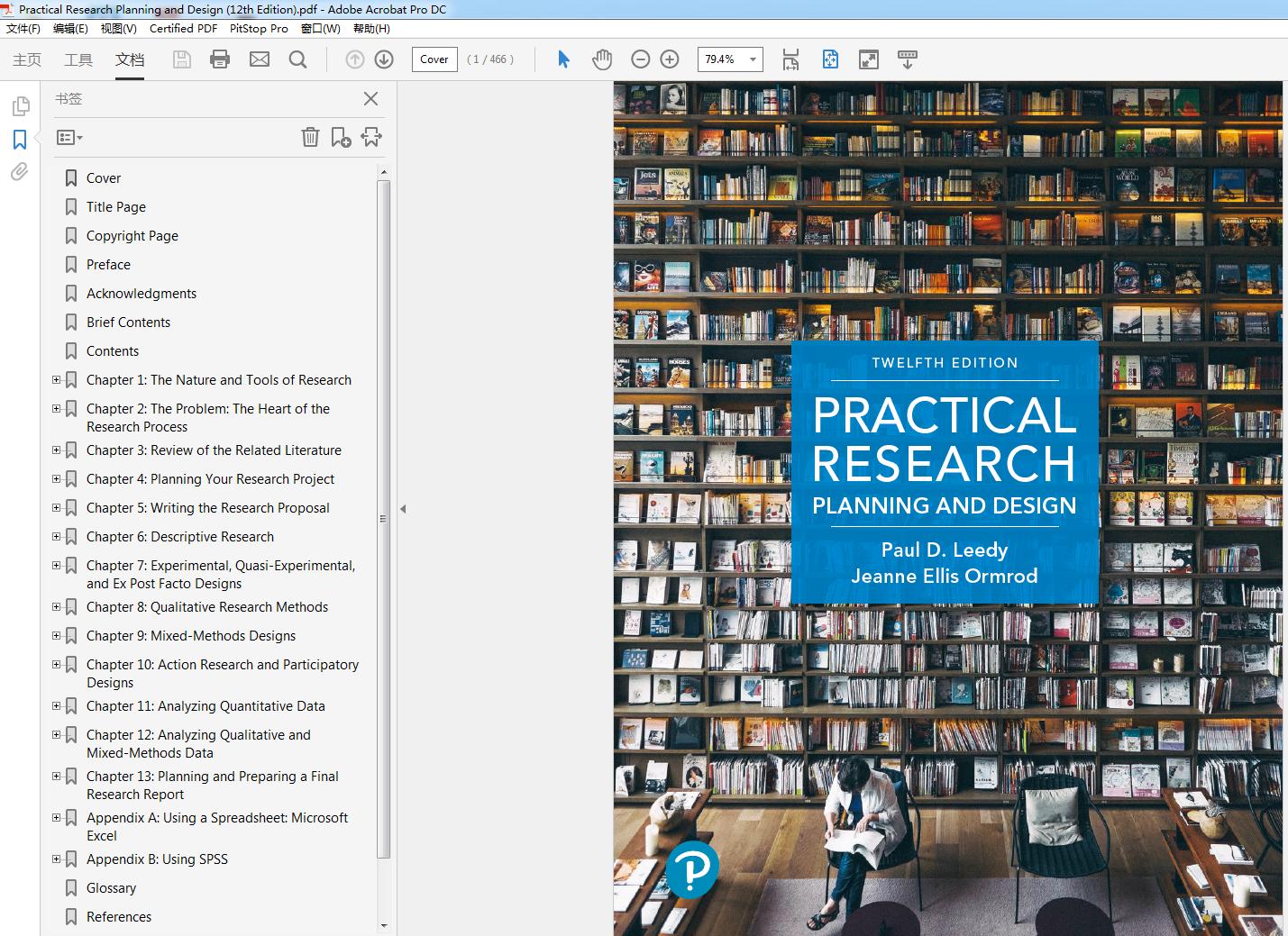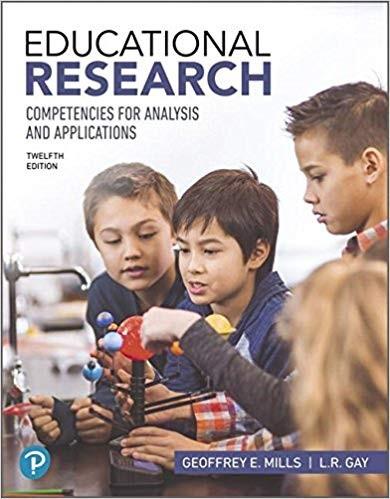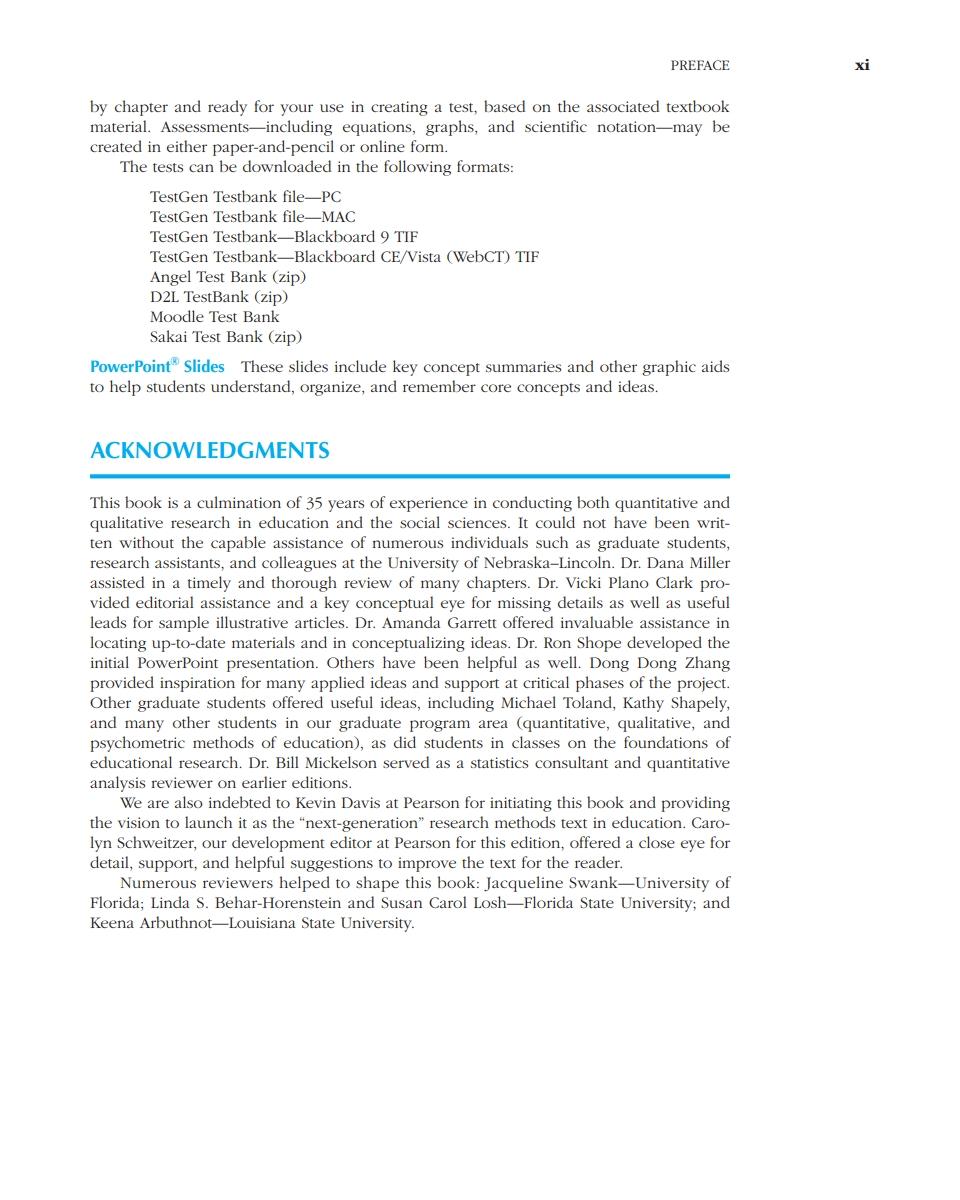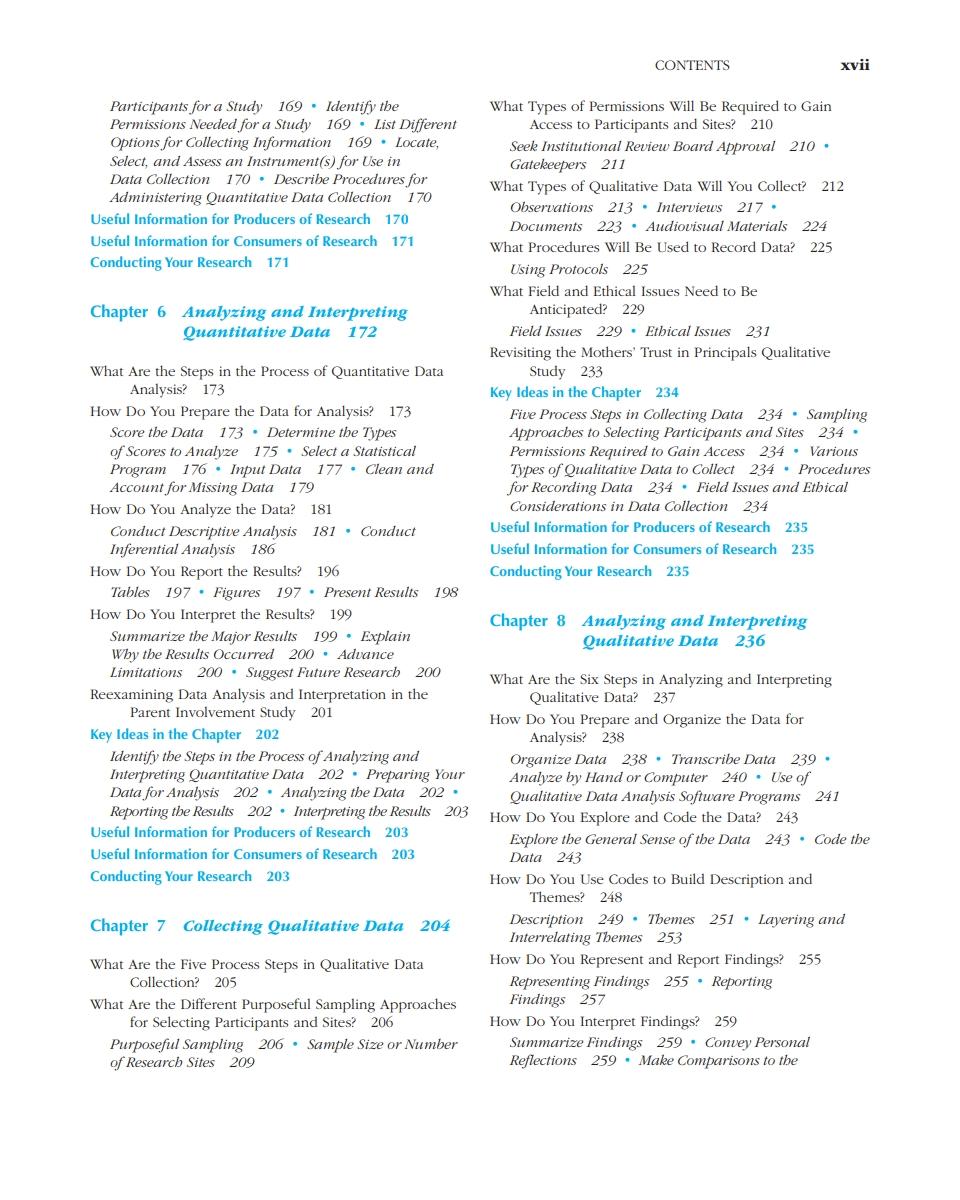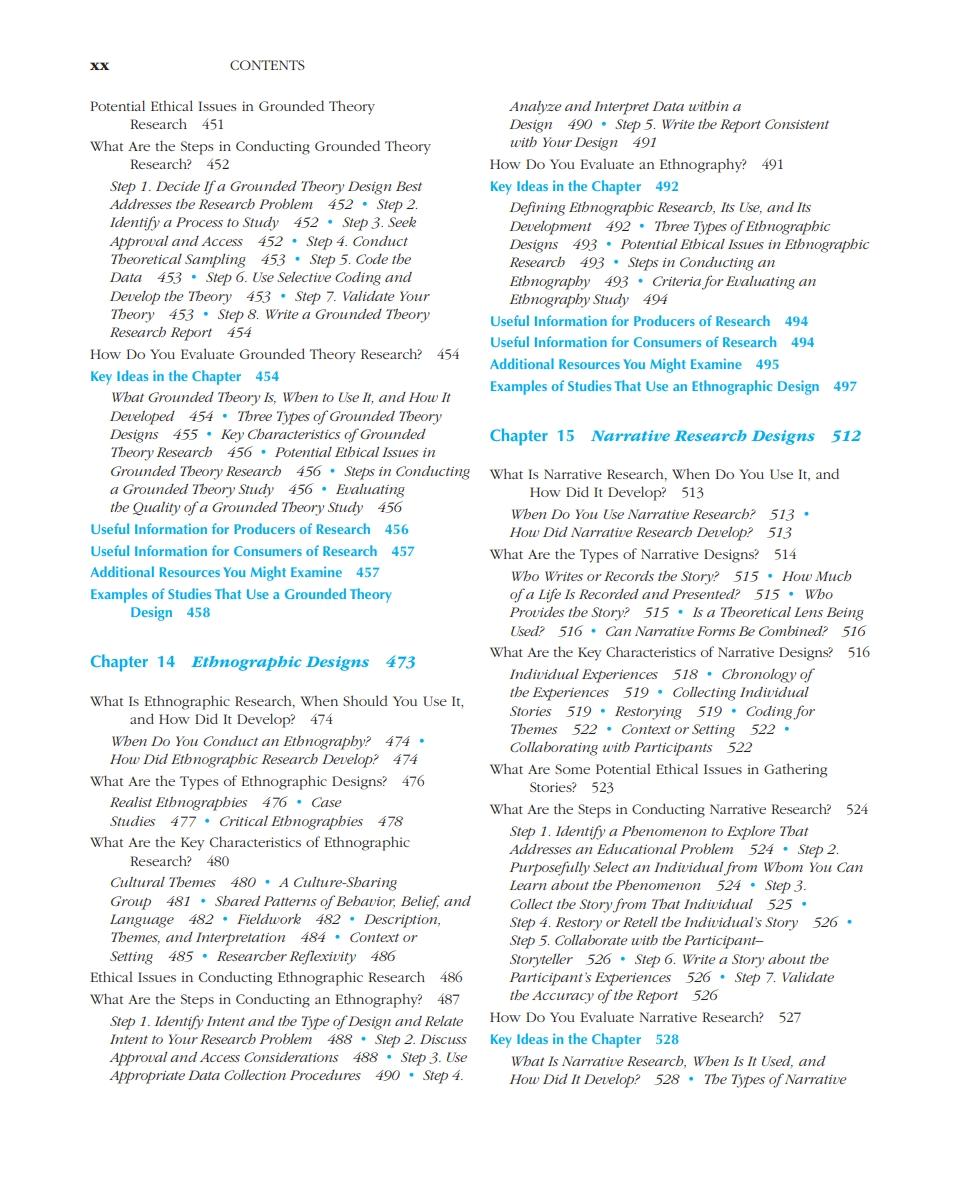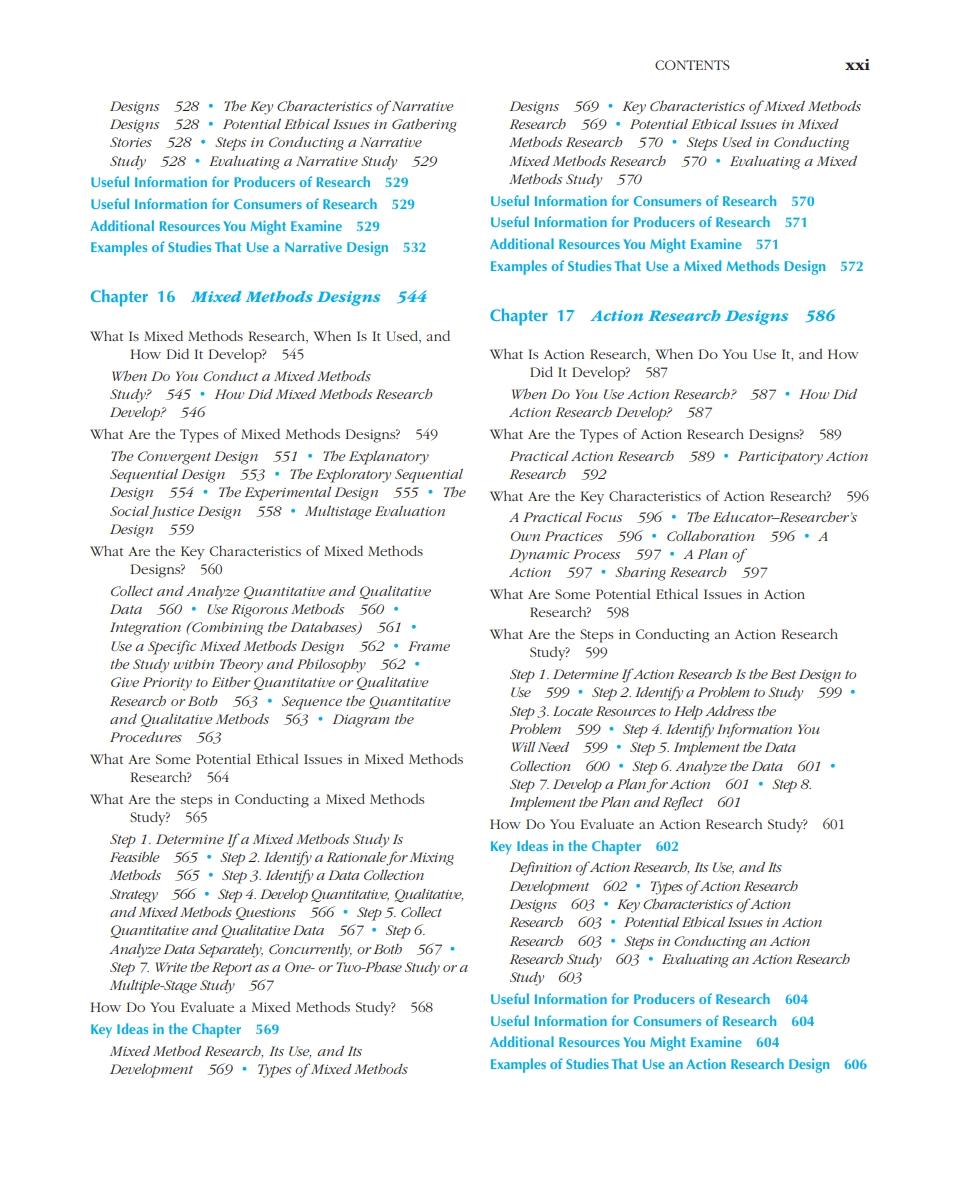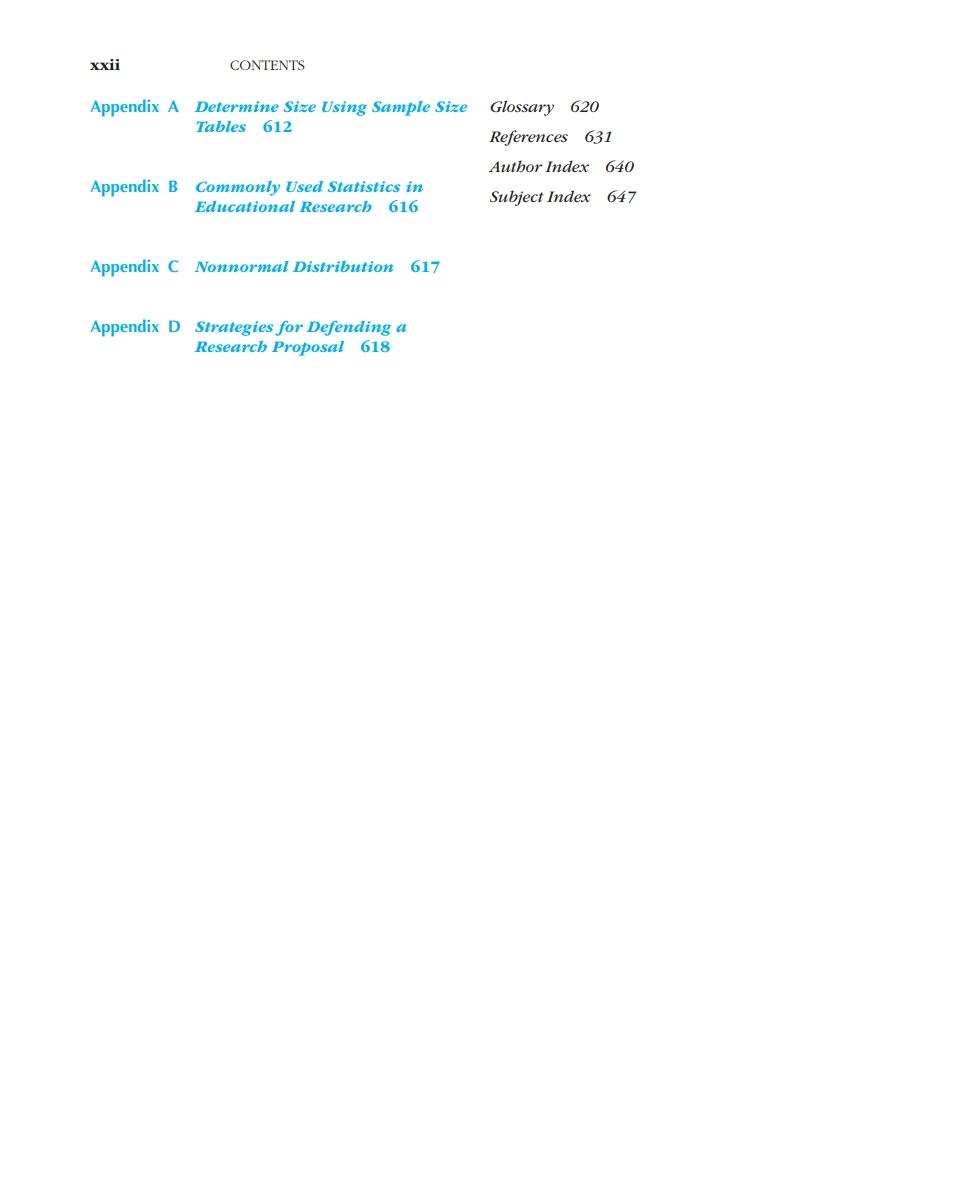THE PHILOSOPHY OF THE TEXT
T h e philosoph y that gu i ded th e deve l opme nt of t his text is twofo l d. First , research involves a p rocess of inte rrelated activ iti es ra th er than th e appl i catio n of i so lated, u n related co n cepts and i d eas Educators p rac ti ce resea rc h follO\Ving a ge n era l seque n ce of p rocedu res-fro n1 the i niti al i de nti fica ti on of a resea rch p rob l em to the fi n a l repor t of research . T h is mea ns that u n d erstan di ng the sequ en ce o r flow of acti vities is ce ntra l to inqu ir y. Th u s, t h e text beg ins w ith specifi c chap ters d evote d to each step i n the p rocess of resea rch a n d t h e in clusio n of concepts and i deas w ith i n th is p rocess.
Secon d , th e educa ti o n al resea r cher today n eeds a la rge toolbox of appr oac h es to s tu dy t h e comp l ex ed u ca t iona l i ssues i n o u r society. No l o nge r can \Ve, as ed u cators, u se o n ly exper i ments o r su rveys to ad d ress ou r researc h p r ob l ems. Ed u ca tors i n t h i s n ew cen tu r y-\vhethe r conduct i ng researc h or readi n g resea r ch to se l f-i n formneed to know abou t q u an ti tative, qua l itati ve , and mixed approaches to inqui r y and to deve l op an in -depth un d ers tandi ng of t h e mu lti ple resea rch d esign s a n d procedu res

used i n ou r stud i es today. I n each s tep i n the process of researc h , thi s text will int rod u ce you to quanti ta ti ve, q u al itative, m i xed methods , and action research approaches. Th roughout t h e tex t , you w i ll lea rn about the differences and si m i larities between q u ali tat ive and q u ant i tative researc h. In the l as t section of the tex t , you w i ll be i ntroduced to e ight distin ct quan t itati ve and qua l itative researc h d es i g ns or procedu res that make up the repe r toire of th e ed u ca t iona l resea rc h er in the q u ant i tative, q u ali tative, and mixed app li cati o n s of r esea rch.
KEY FEATURES
Th i s text offe rs a t n 1ly bala n ced, i nclusive, a n d integra ted ove r view of the f i eld as i t cu rrently sta nds . As you w i ll see from th e tabl e of conte nts, the boo k 's cove rage i s u n i que i n i ts bala n ced presentation of qua n t i tative and qualitative resea rch. Mo reover, it co ns iste ntl y exam i nes fou n datio n al i ssues of resea rc h-fo r exampl e, dete rmi n i ng how to approach a project a n d u nderstand i ng what co nsti tutes d ata a n d h ow to ana l yze them-from qua ntita ti ve, qualitative , a n d m i xed pe rspec ti ves. Th is approach h elps stu d ents understan d th e fu n dame n ta l di fferences and simi l a ri t i es a n1ong these approac h es. Th is text has three mai n p u rposes:
• I t provi des ba l anced coverage of qua nti tati ve and q u al i tative research .
• I t h elps s tu de nts l ea rn h o~, to beg i n to co n duct resea rc h.
• I t h elps s tu de nts l ea rn h ow to read a n d evaluate research studies.
Le t 's look a t these in de tai l to see how each ca n h e l p you ach i eve your course objecti ves.
Balances Coverage of Quantitative and Qualitative Researc h
T hi s text offers ba l anced coverage of a ll types of resea r c h d es i g n s. T hi s p r ov ides
r ea d e rs wit h a comp l ete p i cture of educa t io n al resea rc h as i t i s curre n tly p racti ced.
T h e tex t begins ~ ri th an overview i n Part 1 of the general n ature of ed u cat i onal
r esearch a n d t h e specific q uan t itati ve and q ualitati ve app roac h es to ed u cat i onal r esearch . Nex t , i n Pa r t 2, Chapters 2 t h rough 9 . t h e book exam i nes i n depth t he s teps
i n the r esearch p r ocess :
1. I de n t i fyi n g a research p roblem
2. Rev iewi n g the literatu re
3. Specify i ng a pu rpose a n d resea rch questio ns o r hypotheses
4. Collecti ng e i ther qua nti tati ve o r qua litati ve data
5. Ana l yz i ng and interpreti n g eithe r quantitative o r qual i tative data
6. Repor t i ng and eva l uating the resea rc h
Looki n g a t the p rocess si mu lta n eou s l y from both q u antita tive and qua l itati ve perspectives h elps stude n ts understan d what choices a researcher h as availab l e a n d what mea n i ng exis ts for a parti cu la r cho i ce.
After th is d i scuss i o n , i n Pa r t 3. stu d ents w i ll lea rn th e procedu res fo r con duc tin g specific types of quantita ti ve, q u al i tative , and m i xed method5 stud i es. Chap ters 10 th ro u gh 17 provide ba l a n ced coverage a n d exampl es of each of these types of edu cati ona l resea rc h d es igns : experime n tal , correlatio n al, su r vey, g rou n ded theory, eth n og raph i c, narra ti ve, mixed methods, and act i o n research
Helps Students Learn How to Begin to Conduct Rese arch
Both t h e r esea rch process an d the des i gn chap te rs offer the researc h e r step-by-step gu i da n ce i n th e basi c aspects of p l an n i ng, conductin g, a n d eva l ua t i n g resea rch A n u mber of fea tures gu i d e reade rs t h r o u gh the s teps an d p roced ures of resea rc h . For example, \Ve follow a f i c t iona l beg innin g researc h e r, J\1a r ia, who is a lso a hig h schoo l teac h e r an d n ew g r ad uate stu dent, throug h o ut Pa r ts 2 a nd 3 to i llustrate one researc h e r's effo rts an d to prov ide s tudents w i t h a realistic perspecti ve o n th e p r ocess of resea rch a nd the se l ecti o n of specifi c researc h d esign s Other featu res i ncl ude, but are n ot li m i ted to, the fo ll o\v in g:
• T i ps on pla nn i n g an d con du c ti ng research i n " Usefu l In formati on fo r Producers of Research "
• Ch ecklists th at summa ri ze key poi n ts, such as the eval u ati on c riteria used to assess the qua li ty of a qua n t i tative o r q u al i tative study
• In -text examples of ac tu al an d h ypo th etical stu di es th at i ll us trate t h e correct a n d in co rrect ways of reporting research
Helps Students Learn How to Read and Evaluate Research Studies
D i rect gu i dance on readi n g resea rc h is p rovi ded th ro u g h out the text. To fu rther h el p stu de nts become more ski ll ed at i nterpreti n g an d eva l uati n g resea rc h , the text offe rs a n u mber of fea tu res . Most i n1portant a n1ong t h ese a re the n1an y arti cles i ncluded i n th e text an d th e "Usefi.11 In fo r matio n for Consume rs of Resea rc h " featu re :
• The text p rovi d es a n notated resea rch ar ticles in each of the desi gn chapters i n Pa r t 3. 1\vo other arti cles- one q u alitative , one qua n t i tative-appear a t the e n d of Ch apte r 1. All th ese compl e te a rt i cles ( the re are n umerous othe r, sho rter a rt i cle excerpts i n the book) i n cl u de h ig h l i g h ted n1argi n al an n o tati ons t h at he l p s tu de nts u n dersta n d the structu re of a rticles an d th e key issues w i th wh i ch a reade r should be co ncerned w h en eva l uati n g th e qua l ity an d app li cable scope of eac h pa r ticula r p i ece of resea rc h
• The " Usefi.11 In formati on for Co nsu mers of Resea rc h " fea tu re appea rs a t the end of eve r y chap ter an d offe rs concrete gu i da n ce i n i n te rpre ti ng an d eva l uati n g resea rch.
SUPPLEMENTARY MATERIALS
The foll owi ng resources are availab l e for instructors to downl oa d a t pearsonh ighe red .com/educators :
Onl ine Test Bank The Test Ba nk con tains va rio u s types of ite n1S-multi ple-choi ce, matc hi ng , short essay, and fi ll i n th e blank- for each c h apter Questi ons ask stu de n ts to ide nti fy and d esc ri be resea rc h p rocesses an d d esign characteristics they have learned about an d to classify an d eva lu ate q u antita ti ve a nd qua lita ti ve stu dies and research si tua tio ns.
TestGen Tes tGe n is a powerfu l test ge n era tor available excl us i vely from Pearson Educa ti o n p u b lis h ers You i ns ta ll TestGe n o n you r persona l compute r (Wi n dO\VS o r Maci ntos h) an d c reate you r O\Vn tests fo r class room testing a n d for othe r specia li zed d el i very op ti ons, such as over a l oca l a rea n etwo rk o r on th e Web. A tes t ba n k, w h ich i s also called a Test I tem Fil e (TIP) , typi ca ll y contai n s a la rge set of test i te n1s, orga ni zed
PREFACE
by chapter a n d ready for you r use in crea ti ng a tes t , based on th e associated textbook ma terial. Assessme n ts-incl u d ing equati ons, g raphs, and scientifi c no tati on-may be crea ted i n eithe r paper-and-pencil or o n l i n e form. The tests can be downloaded i n the followi ng formats:
Tes tGen Testbank file-PC
Tes tGen Testbank flle-J\1AC
Tes tGen Testbank-Blackboa rd 9 T I F
Tes tGen Testbank-Blackboa rd CE/Vis ta (Weber) T I F
Angel Test Bank (zi p)
D2L TestBank (z i p)
Mood i e Tes t Bank
Saka i Test Bank (zi p)
Power Poi nt'IJ Slides These slides i nclude key concept summaries and othe r graph i c a i ds to help students understand, o rganize, and remember core concepts and ideas
ACKNOWLEDGMENTS
Th i s book is a culm i na ti on of 35 yea rs of expe ri ence i n conducting bo th q u antita ti ve and q u alitative research in ed u cati on and the socia l sciences. I t co u ld not have been \\' ritten w ithout the capab l e ass istance of n u merous indiv i dua ls su ch as g radu ate s tu den ts, research assi stants , and colleag u es at the Un ivers i ty of Nebraska-Linco l n. Dr Dana M i lle r ass isted in a t i me l y and thorough rev i e\\, of many chapte rs. Dr. V i cki Plano Cla rk prov i ded ed itorial assis tance and a key concep tu al eye fo r m i ssing details as well as useful l eads for sample illus tr ative arti cles. Dr. Amanda Garrett offe red i nvaluable assi stance i n l ocati ng up-to-da te materia l s and in conceptua li zi ng i deas. Dr. Ron Shope developed the i nitial Powe rPoi n t p resentation. O thers have been helpful as well. Dong Dong Zhang provided inspira ti on for many applied i deas and support at cri t i ca l phases of the proj ect. Othe r g raduate students offered useful i deas, i ncluding M i chael Toland, Ka thy Shape l y, and many o ther student5 i n ou r graduate program a rea (quan titati ve, qua l ita ti ve, and psychome tri c me thods of education), as did stu den ts i n classes on the founda t i ons of educa ti ona l research . Dr. B i ll M i cke lson served as a sta ti sti cs consu ltan t and quantita ti ve ana lysis revi ewer on earl i er ed it i ons.
\Ve a re a lso i ndeb ted to Kev i n Dav is a t Pearson for in iti ati ng th i s book and prov iding the v isi on to launch i t as the " next-generati on " resea rch methods tex t in edu cati on. Carol yn Schwe i tzer, o u r deve l opment editor a t Pearson for this ed iti on , offe red a close eye fo r de tail, support , and he l pfi.11 sugges t i ons to imp rove the text for the reader.
Nume rous rev i ewe rs he l ped to shape th i s book: Jacqueline Swank-U nive rs i ty of Flo ri da; Linda S. Beha r-Ho rens tein and Susan Ca rol Losh-F lo ri da State Unive rsi ty; and Keena Ar b uthnot-Lou is i ana State Un ivers i ty.
Th i s page inte nti o nally le ft b lank
Detailed Contents
Preface vii
Brie}· Contents xiii
PART 1 An I n t rodu c t ion to Edu cation al Re search 1
Chapter 1 The Process of Cond ucting R esea rch Using Qu a n ti tative a nd Qu ali ta tive Approach es 2
A Definition of Research and IL~ hnportance 3
Research Adds to Our Knowledge 4 • Research Improves Practice 4 • Research Informs Policy Debates 6 • Several Proble111s w ith Research 1bday 6
T h e Six Steps in th e Process of Research 7 Identifying a Research Problem 7 • Reviewing tbe literatu,·e 8 • Specifying a Pu,posefor Research 9 • Collecting Data 9 • Analyzing and l nte,preling tbe Data JO • Reporting and Evaluating Research JO
The Ch aracte 1istics of Quantitative and Qua l itative
Researc h i n Eac h of th e Six Steps 11 Quantitat ive Resea,·ch Characteristics 13 • QualitatitJe Research Characteristics 16 • Sim ilarit ies and Differences bet11,een Quantitat ive and Qualitative Research 19 • Research Designs Associated with Quantitat ive and Qualitative Researd1 20
I mportant Eth ica l Issues in Conducti n g Resea rch 22 In stitutional Review Board~ 22 • Prq/essional Association~ 23 • Ethical Practices throughout the Research Process 23
Skills Needed to Design and Co nd uct Research 24
Solving Puzz les 25 • lengthen ing Your Allen lion Span 25 • Learning to Use Library Resources 25 • \Vriting , Editing, and 1l1ore \Vriting 25
Key I deas in t he Chapter 26 7be Definition and Importance c,fEducalional Research 26 • 11x, Six Steps in tbe Process of
Research 26 • 1be Characteristics c,fQuanlitative and Qualitaliw Research 26 • Y11e Types c,{ Research Designs Associated with Quantitaliue and Qualitaliw Research 26 • 11x, Important Ethical l,;sues 2 7 • 11x, Skill~ 1Veeded to Design and Conduct Research 2 7
Useful Information for Producers of Research 27
Useful Information for Consumers of Resea rch 27
PA RT 2 The Step s in the Process of Resea rch 57
Chapter 2 Identifying a R esea rch Proble » i 58
\Vha t ls a Research Prob lem, a nd \ Vhy Is I t I mportant> 59
llow Does t h e Research Probl em Differ from O ther Parts of Research> 59
Ca n a nd Shou ld Problems Be Researched> 61
Can You Gain Ace~~ to People and Sites? 61 • Can You Find Time, l.ocate Resources, and Use Your Skills' 61 • Should the Problem Be Researched' 62
I low Does t h e Research Prob lem Differ in Quantitative a nd Qua l itative Resea rch? 63
I low Do You Write a "Sta tement of t h e Prob lem " Sectio n > 64
The Top ic 64 • 7be Research Proble,11 66 • Justification c,{tbe Importance c,{tbe Problem 66 • Dt!ficiencies in \\'fbat \Ve Know 69 • 7be Audience 70
\Vha t Are Some Stra tegies for \ Vriting t h e 'Sta tement of t h e Problem ·· Section > 70
A Template 70 • Other \\'/riling Strategies 7 1
Examples of '·Statement of the Probl em " Sections 7 2
Reexamining the Parent I n vo l vement and the Mothers ' Trust in Sc h ool Principals Studies 75
Key Id eas in t he C hapter 76 De.fine a Researd1 Prohle,11 and E.>.plain Its Importance 76 • Distinguish between a Research
Proble,n and Other Parts of Research 76 • Criteria for Deciding \Vhelher a Prohle,n Can and Should Be Researched 76 • The D{!Jerence be/ween Quantilative and Q11alitalive Research
Problems 76 • 1be Five Ele,nenls of a "State,nent qfthe Prohle,n " Section 76 • Strategies Us~f11I in \Vriling the "Statetnent q( the Problettt " Section 76
Useful Infor mation for Pro d ucers o f Resea rc h 76
Useful Infor mation for Consume rs of Research 77
Chapter 3 R eviewing th e Lite rature 78
What ls a Literature Review, and \'Xlhy ls It Important> 79
How Does the lileratu,·e Review Differfor Quanlitative and Qualitatiue Studies? 79
What Are the Six Steps in Conducting a Literature Review> 80
Identify Key Terms 81 • locate lileratu,·e 82 • Critically Evaluate and Select /he Literature 91 • Organize the lilerature 92 • Synthesize the li1erat11re 94 • \Vrite a Literature Review 96
Reexamining the Parent Involvement and the Mothers· Trust in P ,incipa ls Studies 103 lilerature Review Ana()•sis in a Quantitati1;e Study 104 • Literature Review Analysis in a Qualitative Study 104
Key Id eas in t h e Chapt er 105 \Vbat Is a Review q(lhe Literalure, and \17f~y ls Tr Important? 105 • The Six S1eps in Cond11cting a li1erat11re Review 105
Useful Infor mation for Producers o f Resea rc h 10 6
Useful Infor mation for Consume rs of Research 107
Condu c ting Your Research 1 07
Chapter 4 Specifying a Purpo s e and Researc h Qtiestions or Hy potheses 108
What Are Purpose Statements, Research Questions, llypotheses , and Objectives' 109
The P11,pose S1ate1nen1 109 • Research Q11estion5 110 • l-~ypotheses 110 • Research Ohject i ves 1 11
Why Are These StatemenLs and Questions Important> 11 1
I low Do You Design Quantitative Purpose Statements , Research Questions, and I lypotheses' 1 11
Spec!fj, Variables 112 • The Family qf Variables 113 • Theories and Testing q( Variables 119 • \Vriling Quantitative Pu,pose
State,nents 122 • \Vriting Quautitalive Research Queslions 123 • \Vriting Q11anlitaliie l-f}potbeses 125
I low Do You Design Qua litative Purpose Statements and Research Questions' 127
D{!Jerenlialing be/u,een Q11anti1ative and Qualilalive Purpose Statements and Research Q11estions 127 • The Central Phenomenon in Q11ali1a1ive Research 128 • Emerging Processes in Q11ali1a1ive Researd1 129 • \Vriting Q11alita1ive Purpose Statetnents 130 • \rlriting Qualitative Research Queslions 131
Reexamining the Parent Invo lvement and Mothers· Trust in Principals Studies 135
Key Id eas in t h e C h apter 136
Dislinguish among P11rpose S1a1e1nen1s, Research Questions, l-lypotheses, and Objecti1,es 136 • Know \17f~y These Statements and Q11estion5 Are lmpona,u 136 • \\7iite Q11anti1ative Purpose State,nents, Research Queslions, and l-lypotheses 136 • \Vrite Qualilative Purpose
Sta/e1nents and Research Questions 136
Useful Informa tion for Produce rs o f Research 1 37
Useful Informa tion for Co nsumers of Resea rc h 1 37
Condu cting Your Research 137
Cha pter 5 Collecting Quantitative Data 1 3 8
Five Steps in the Process of Data Collection 138
\Vhat PanicipanLs Will You Study? 139
Identify Your Unit ofAnalysis 139 • Specify /he Population and Sa,nple 139
\'Xlhat Pennissions \Viii You Need> 144
Oblain D!fferenl T)pes q(Pennissions 145 • Obtain Informed Consent 145
\Vhat Are Your Options for Co llecting lnfonnation? 147 Spec!f'y Variablesfro,n Research Queslions and Hypotheses 148 • Operalionally Define Each Variahle 148 • Choose 1'ypes q(Data and 1l1easures 149
\'Xlhat Instrument \Vi ii You Use to Collect Data> 156 Locate or De1,elop an lnstr11111e11t 156 • Seard1for an ht5trument 157 • Criteria for Choosing a Good lnstnunent 157
!low \Viii You Ad1ninister the Data Co llection' 167 Standardizalion 167 • Ethical l5sues 168
Reexan1ining d1e Quantitative Parent Involvement Study 168
Key Id eas in t h e C h apter 169
Stale /he Five Steps in the Process qf Quantilalive Data CollecUon 169 • Identify How 10 Selecl
ParticipanL~for a Study 169 • Identify the Pen11is~io11s 1Veededfor a Study 169 • list Different Options.for Collecting lnfonnation 169 • locate, Select, and Asse~s an l11stn1111ent(~) for Use in Data Collection 170 • Describe Procedures.for Administering Quantitat ive Data Collection 170
Useful Infor mation for Producers of Resea rch 1 7 0
U seful In for mation for C onsume rs of Research 171
Condu cting Your Research 171
Cha pter 6 Ana lyzin g a nd I n terpre ting Qu antitative Dat a 1 72
What Are the Steps in the Process of Quantitative Data Analysis> 173
How Do You Prepare the Data for Ana lysis> 173
Score the Data 173 • Determine tbe 1)pes q(Scores to Analyze 175 • Select a Statistical Progrant 176 • Input Data 177 • Clean and Account.for 1\1issing Data 179
llow Do You Analyze the Data? 181
Conduct Descripti1Je Analysis 181 • Conduct Inferential Analysis 186
How Do You Repo11 the Results> 196 Tables 197 • Figures 197 • Present Results 198
llow Do You Interpret the Results> 199
S1u111narize tbe 111ajor Resu/L~ 199 • E>.plain \\7hy tbe Resu Its Occurred 200 • Adva nee limitations 200 • Suggest Future Research 200
Reexamining Data Ana lysis and [ nte ,pretation in t he Parent Involvement Study 20 1
Key I deas in t he Chapter 202
Identify the Steps in the Process qfAna{yzing a11d Interpreting Quantitative Data 202 • Preparing Your Data.for Ana{J ,sis 202 • Analyzing the Data 202 • Reporting the Resu!L~ 202 • ln1e,preting the Resu!L~ 203
U seful In for mation for Producers of Resea rch 2 0 3
U seful In for mation for C onsume rs of Research 203
Condu cting Your Research 203
Cha pter 7 Collec ting Qualitati ve Dat a 2 04
What Are the Five Process Steps in Qua li tative Data Co llection> 205
What Are the Different Pu ,poseful Sampling Approaches for Selecting Participants and Sites> 206
Pu,poseful Sampling 206 • Sample Size or 1V111nber qf Research Sites 209
COJ\'TENTS
\X' hat Types of Pe ,missions \17i ll Be Required to Ga in Access to Participants and Sites> 210
Seek l11stitutional RetJiew Board Approval 210 • Gatekeepers 211
\X' hat Types of Qualitative Data \17ill You Coll ect? 212
Observations 213 • Interviews 217 • Doc1u11ents 223 • AudiotJisual ll1aterials 224
\Xlhat Procedures \X' ill Be Used to Record Data> 225
U.~i ng Protocol~ 225
\Xlhat Field and Ethical Issues Need to Be Anticipated? 229
Field Issues 229 • Ethical Issues 231
Revisiting t he Mothers ' Trust in Principa ls Qua lita tive Study 233
Key I deas in t he C hapter 234
Five Process Steps in Collecting Data 234 • Sa111pling Approaches to Selecting Participants and Sites 234 • Pentti&~ons Required to Gain Access 234 • Various Types of Qualitative Data to Collect 234 • Procedures for Recording Data 234 • Field Issues and Ethical Considerations in Data Collection 234
Useful Informa t ion for Producers of Research 235
Useful Informa t ion for Consumers of Resea rch 235
Condu cting Your Research 235
Cha pter 8 Analyzing an d I n t e rpreting Qualitative D a t a 23 6
\Xlhat Are the Six Steps in Ana lyzing and Inte ,preting Qualitative Da ta> 237
llow Do You Prepare and Organize the Data for Ana lysis> 238
Organize Data 238 • Transcribe Data 239 • Analyze by Hand or Computer 240 • Use of Qttalitative Data Analysis Sq(tware Progra111s 241
llow Do You Exp lore and Code the Data> 243
£yplore tbe General Sense<!( the Data 243 • Code the Data 243
llow Do You Use Codes to Build Description and Themes> 248
Description 249 • 111e111es 251 • layering and Interrelating 1bemes 253
llow Do You Represent and Report Findings> 255
Representing Findings 255 • Reporting Findings 257
llow Do You Interpret Findings> 259
Sttmtttarize Findings 259 • Conuey Personal R(!/lecUons 259 • 1l1ake Compari~o11s to the
litemture 260 • Oiler limitations and Suggestions .for Future Research 260
I low Do You Validate the Accuracy of Your Findings> 261
Reexamining Qualitative Data Ana lysis in the Mothers ' Trust in P,incipa ls Case Study 262
Key Ideas in t h e Chapter 263
SLr: Steps in the Process ofAnalyzing and lnte,preling Qualitalive Data 263 • Prepare and Organize the Data/or Ana!)'Sis 263 • Explore and Code the Data 263 • Coding to Build Description and 1he111es 263 • Represent and Report Qualitative Findings 264 • lnte,pret 1be Findings 264 • Validate tbe Accuracy<!( the Findings 264
Useful Infor mation for Producers of Resea rc h 264 Useful In for mation for Consume rs of Research 265 Condu cting Your Research 265
Cha pter 9 R epo rting a nd Evalua t i n g R esearch 266
What ls a Research Report , and \'Xlhat Are Its Types> 267 If/bat Audience \Vilt Receive the Report' 267 • \Vbat Are tbe Types<!( Research Repor1s' 268
Mow Shou ld You Structure Your Report> 273
look at /he Physical Structure<!( Research Reports 273 • Design an Appropriate Quantilative S1n1cture 274 • Design an Appropriate Qualitative Struc/ure 274
How Do You \\/'rite in a Sensitive , Ethical , and Scholarly Way' 278
Use language Thal Reduces Bias 278 • Encode Scholarly Terms inlo Your Research 279 • Use Ethical Reporting and \Vriting of Resea,·cb Results 280 • Use an Appropriate Point qf View 281 • Balance Your Research and Contenl 282 • lnlerconnect Sec/ions .for Consistency 282 • Advance a Concise Title 283
Mow Do You Evaluate the Quality of Your Research? 284 Employ Appropriate Standards 284 • Quan ti/alive Standards 284 • Qualilative S1andard~ 285 • Evaluate wilb a Process Approach 286
Reexamining the Parent Involvement and Mothers' Trust in P ,incipa ls Studies 289
Key Id eas in t h e Chapter 289
The Pu ,pose <!fa Research Repon and Its Types 289 • How to S1nu:1ure Your Research Reporl 290 • Sensitive, Ethical, and Scholarly \Vriting Practices 290 • Criteria .for Evaluating a Research Report 290
Useful In for mation for Producers of Resea rc h 29 0
Useful In for mation for Consume rs of Research 291
Condu cting Your Research 291
PART 3
Research Des ign s 293
Cha pter 10 Experim e ntal D esig n s 2 94
\'Xlhat ls an Expe ,iment, \\/'hen Should You Use It, and llow Did It Deve lop' 295
\'v'ben Do )'ou Use an £r:periment' 295 • Making Causal hiferences 295 • \'v'ben Did Experi111en1s Develop? 296
\'Xlhat Are Key Characteristics of Experiments> 297 Rando111 Assign111en1 297 • Control over Extraneous Variables 298 • ll1anipulating Treatment Condition~ 302 • Outcome .ll1easures 303 • Group Comparisons 303 • 1breats to Validity 305
\X' hac Are the Types of Experimenta l Designs' 309 Be11veen-Group Designs 310 • \Vi/bin-Group or Individual Designs 316
\'Xlhat Are Potentia l Ethical Issues in Expe ,imenta l Research? 324
\'Xlhat Are the Steps in Conducting Experimental Research? 326
Step 1 Decide!(an £r:periment Addresses )'our Research Problem 327 • Step 2 For,11 Hypotheses to Test Cause-and-Effect Relationships 327 • Step 3 Select an E:>.perimental Unit and ldenl!{y Study Panicipants 327 • Step 4. Select an £r:peri111ental Trea1111en1 and Introduce It 328 • Step 5 Choose a Type of Experi111ental Design 329 • Step 6 Conduc/ the E:>.peri111ent 329 • Step 7. Organize and Ana(yze tbe Dala 329 • Step 8 Develop an £r:perimental Researd1 Repor1 329
I low Do You Evaluate Expe,imental Research? 330
Key Id eas in t h e C hapter 331
A Definilion of Experi111e111al Research , \flben lo Use fl, and How ft Developed 331 • Key Cbaracterislics <!f E:>.perintental Research 331 • Types qf £r:perimental Design~ 331 • Ethical l.~~ues in £r:perimental Resea,·cb 331 • Steps in Conducling an £r:periment 332 • Evaluating an £r:periment 332
Useful Information for Producers o f Research 332
Useful Information for Consumers of Resea rc h 333
Addi tiona l Resou rces You Migh t Examin e 333
Cha pter 11 Co rrelational D esigns 342
\'Xlhat ls Con elaliona l Research, \X' hen Do You Use It , and llow Did It Deve lop' 343
\'v'ben Do )'ou Use Correlational Research? 343 • !-Tow Did Correlational Research Develop? 343
What Are the Types of Corre lationa l Designs' 345 Y11e Explanatory Design 345 • Tbe Prediction Design 346
What Are the Key Characte 1istics of Correl ationa l Designs' 347
A5sociations betu)(1en Scores 348 • Displays<!( Scores 351 • ll1ultiple Variable Analysis 353 • Using Advanced Correlatinnal Statistical Procedures 358
Potentia l Ethical I ssues in Conducting Correlationa l Research 362
What Are the Steps in Conducting a Corre lational Study? 363
Step 1. Determine [(a Correlational Study Best Addresses the Research Problem 363 • Step 2 Identify Tndividual5 to Study 364 • Step 3. lde11.t//y Two or More Measures/or Eacb Individual in the Study 364 • Step 4. Collect Data and i'ifo11.itor Potential 1breats 364 • Step 5. Analyze the Data and Represent tbe Results 365 • Step 6 . !11.te1pret tbe Results 366
I low Do You Eva l uate a Corre l ational Study' 366
Key Ideas in t he Chapter 367
Y11e Definition, Use, and Develop,nent <!( Correlational Research 367 • Types of Correlational Designs 368 • Key Characteristics of Correlational Designs 368 • Ethical l5su.es in Conducting Correlational Research 368 • Steps in Conducting a Correlational Study 368 • Criteria for Evaluating a Correlational Study 369
Useful Info r mation for Producers of Resea rc h 369
Useful Info r mation for C onsume rs of Research 369
Additiona l Resources You Might Exami ne 369
Exampl es of Studies That Use a Survey Design 370
Cha pter 12 Survey D esigns 384
What ls Survey Research, \Vhen Do You Use It, and I low Did I t Develop' 385
\Vben Do You Use Sur1Jey Research? 385 • flow Did Suruey Research Deuelop? 385
What Are the Types of Survey Designs' 386
Cross-Sectional Survey Desig11.5 386 • Longitudi11.al Suruey Designs 388
What Are the Key Characteristics of Survey Research' 389
Sa111plingfro,11 a Population 390 • Questionnaires and Interviews 391 • h-t5tru,nent Design 394 • Response Rate 399
I low Do You Construct and Analyze an Online or Mailed Questionnaire? 401
The Couer letter 402 • 01Jerall Qu.estinnnaire Construction 402 • Data Analysis <!(a Research Questionnaire 408
I low Do You Design and Conduct an I nterview Survey? 409 Stance of the Interviewer 409 • Training<!( lntervie1.1,ers 409 • Steps in Interviewing 409 • A Telephone Interview Guide 410 • Unique Considerations of Telephone Interviews 410
\Xl hat Are Potentia l Ethical Issues in Survey Research' 412
\Xlhat Are the Steps in Conducting Survey Research' 413 Step 1 Decide [( a Survey ls the Best Design to Use 413 • Step 2. !dent(fy the Research Questions or Hypotheses 413 • Step 3 . ldent/{y tbe Population, the Sa,npling Frame, and the Sa,nple 413 • Step 4 . Detennine the Sur1Jey Design and Data Collection Procedures 414 • Step 5 . Develop or Locate an Tnstrurnent 414 • Step 6. Ad111inister the h-t5trument 414 • Step 7. Ana(yze tbe Data to Address the Research Questions or f~ypotheses 414 • Step 8. \Vrite the Report 414
llow Do You Evaluate Survey Research' 415
Key Id eas in t h e C hapter 415
Dftf,ning Survey Research , \Vben to Use It, and How It Delleloped 415 • Type.5 <!fSu ruey Design5 415 • Key Characteristics <!fSu roey Research 415 • Con5tructing and Using an Online or ,Wailed Questionnaire 417 • Designing and Conducting an Interview Survey 417 • Potential Ethical l.~n,es in Survey Research 417 • Steps in Cond11cti11.g Suruey Research 417 • Criteria.for Evaluating Suruey Research 41 7
Useful Information for Producers o f Research 418
Useful Information for Consumers of Resea rc h 418
Addi tiona l Resou rces You Migh t Examin e 4 18
Exa mp les of Studi es Tha t Use a Su rvey Design 420
Cha pter 1 3 Grounde d Th eory D esign s 433
\Xl hat ls Grounded Theory Research , \Vhen Shou ld You Use It, and How Did It Deve lop' 434 \Vben Do l'ou Use Grounded 1beory' 434 • How Did Grou11.ded Theo,y Develop.' 434
Types of Grounded Theory Designs 435
The System.atic Design 435 • The E,nerging Desig11 440 • 111e Constn,ctivist Design 441 • Cboosing a,nong the Designs 442
The Key Characteristics of Grounded Theory Research 442
A Proce.~5 Appr'OClch 443 • 1beoretical Sampling 444 • Constant Co111paratiue Data Aua{)>Sis 445 • A Core Category 446 • Y11eory Generation 44 7 • 1"1e111os 450
Potentia l Ethica l Issues in Grounded Theory Research 451
What Are the Steps in Conductin g Grounded Theory Research' 452
Step 1. Decide!( a Grounded Theory Design Best Addresses the Research Problem 452 • Step 2
Identify a Process to Study 452 • Step 3. Seek Approval and Access 452 • Step 4. Conduct Y11eoretical Sampling 453 • Step 5 . Code tbe Data 453 • Step 6. Use Selective Coding and Devel.op the 1beory 453 • Step 7. Validate Your Y11eo1 y 453 • Step 8 \Vri te a Grounded Theory Research Report 454
I low Do You Eva l uate Grounded Theory Research> 454
Key Id eas in t he Chapter 454
\Vbat Grounded Theo,y l5, \Vben to Use It, and !-Tow It Developed 454 • Three 1j,pes of Grounded 11Jeory Designs 455 • Key Characteristics qf Grounded Y11eory Research 456 • Potential Ethical Issues in Grounded Y11eory Research 456 • Steps in Conducting a Grounded Theory Study 456 • Evaluating tbe Quality qfa Grounded 1beo1y Study 456
Useful Info r mation for Producers of Resea rc h 456
Useful Infor mation for C onsume rs of Research 4 57
Additiona l Resources You Might Exami ne 457
Exampl es of Studies Tha t Use a G rounded Th eory Desig n 458
Cha pter 14 E thnographic D esi gns 473
What ls Ethnographic Research , \\/'hen Shoul d You Use It, and How D id I t Deve lop? 474
\Vben Do You Conduct an Ethnography? 4 74 • How Did Ethnographic Researd1 Develop> 474
What Are the Types of Ethnographic Designs> 476 Realist Ethnographies 4 76 • Case Studies 4 77 • Critical Ethnograpbies 478
What Are the Key Characte 1istics of Ethnographic Research' 480
Cullural Tbe111es 480 • A Culture-Sharing Group 481 • Shared Patterns of Behavior, Beli(!/; and language 482 • Fieldwork 482 • Description, Y11e111es, and Tnte,pretati.on 484 • Conte.xi or Selling 485 • Researcher R(!/lexivity 486
Ethical Issues in Conducting Ethnographic Research 486
What Are the Steps in Conductin g an Ethnography? 487
Step 1. Tde11t(fy Intent and tbe 1jpe qfDesign and Relate Intent to )b ur Researd1 Prohlent 488 • Step 2. Discuss
Approval and Acce.~5 Considerations 488 • Step 3. Use AppropriaJe Data Coll.ection Procedures 490 • Step 4.
A11a{yze a11d Interpret Data within a Design 490 • Step 5 \Vrite tbe Report Co11sisten1 witb Your Design 491
I low Do You Evaluate an Ethnography' 491
Key Id eas in t h e C hapter 492
Defining Ethnographic Re.5earch, Its Use, and fL5 Deuel.op,nent 492 • Three Types of Ethnographic Designs 493 • Potential Ethical l5sues in Etbnograpbic Researcb 493 • Steps in Conducting an Etbnograpby 493 • Criteria for Evaluating an EtbnograpbyStudy 494
Useful Information for Producers o f Research 494
Useful Information for Consumers of Resea rc h 494
Addi tiona l Resources You Migh t Examin e 495
Exa mp les of Studi es Tha t Use an Et hn ographic Design 497
Cha pter 1 5 N a rrative R esear ch Designs 5 1 2
\Xl hat ls Narrative Resea rch , When Do You Use I t, and llow Did It Deve lop> 513
\Vhen Do l'ou Use 1Varrative Research > 513 • How Did 1Varratiue Re.5earch Develop? 513
\Xl hat Are the Types of Narrative Designs> 514
\Vbo \Vrile.5 or Records tbe Story' 515 • How 1'4uch qfa Life l5 Recorded and Presented' 515 • \Vbo Provides the Story> 515 • l~ a 1beoretical Len5 Being Used> 516 • Can 1Varraliue Fonns Be Combined? 516
\Xlhat Are the Key Characteristics of Narrative Designs> 516 Indiv idual Experiences 518 • Cbronol.ogy qf tbe b.periences 519 • Collecting Individual Stories 519 • Re.5toi ying 519 • Coding.for T11e1nes 522 • Context or Selling 522 • Collaborating wilb Participants 522
\Xlhat Are Some Potential Ethica l I ssues in Gathe,ing Stories' 523
\Xl hat Are the Steps i n Conducting Narrative Research? 524
Step 1 ldent!(y a Phenon1enon to Explore That Addresses an Educational Proble,11 524 • Step 2 Purpos(!/itlly Select an Individual fro111 \Vbont )bu Can Lean1 about tbe Pheno,nenon 524 • Step 3. Collect /be S101y fro111 Thal Individual 525 • Step 4 Restory or Retell the l11dividua/:5 Story 526 • Step 5 Collaborate witb tbe ParlicipanlStoryteller 526 • Step 6 \\)l'ite a Sto,y about the Participants E.>.perience.5 526 • Step 7 Validate tbe Accuracy of tbe Report 526
llow Do You Evaluate Na rrative Research' 527
Key Id eas in t h e C h apter 528
\'Vba t ls 1Varratiue Re.5earch, \Vben ls ft Used, and !-Tow Did ft De1Jelop.> 528 • 1be 1jpes qf 1Varratiue
xxi
Designs 528 • Y11e Key Characteristics of 1Varratiue Designs 528 • Potential Ethical Issues in Gathering Stories 528 • Steps in Conducting a !Varratiue Study 528 • Eualuating a A'arratiue Study 529
Useful Info r mation for Producers of Resea rc h 529
Useful Info rmation for Co nsume rs of Research 529
Additiona l Resources You Might Exami ne 529
Exampl es of Studies That Use a Narrative Design 532
Chapter 16 M ixed M eth od s D esigns 544
What ls Mixed Methods Research, \Vhen rs [t Used, and Ilow Did [t Develop' 545
\\!'hen Do You Conduct a Mixed 1l1ethods Study> 545 • flow Did 1l1ixed 1l1ethods Research Devel.op.' 546
What Are the Types of Mixed Methods Designs' 549 Y11e Convergent Design 551 • The Explanatory Sequential Design 553 • Ybe Explorato,y Sequential Design 554 • 711e £yperimental Design 555 • The Socia/Justice Design 558 • ll1u/tistage Evaluati.on Design 559
What Are the Key Characte1istics of Mixed Methods Designs? 560
Collect and Anaryze Quantitative and Qualitative Data 560 • Use Rigorous 1l1ethods 560 • Integration (Combining the Databases) 561 • Use a Spec(fic .#ixed ,11ethods Design 562 • Frame the Study within Theory and Philosophy 562 • Give Priority to Either Quantitative or QualitatitJe Research or Both 563 • Sequence the Quantilatiue and Qualitatiue Methods 563 • Diagram the Procedures 563
What Are Some Potential Ethical Issues in Mixed Methods Research' 564
What Are the steps in Conducting a Mixed Methods Study? 565
Step 1. Determine [(a 111ixed Methods Study l~ Feasible 565 • Step 2 Identify a Rationale/or 1l1ixing Method~ 565 • Step 3. Identify a Data Collection StraJegy 566 • Step 4. Deuelop Quantitative, Qualitative, and 111ixed 1l1ethod~ Question~ 566 • Step 5. Coll.ect Quantitalii-e and Qualitatiw Data 567 • Step 6. Anaryze Data Separately, Concurrentry, or Both 567 • Step 7. \\7rite the Report as a One- or Tu;o-Phase Study or a Multiple-Stage Study 567
l low Do You Evaluate a Mixed Methods Study' 568
Key Id eas in t h e Chapter 569
Mixed .#ethod Research, Its Use, and TL~ De1,-e!.op111ent 569 • Types of Mixed Methods
Design~ 569 • Key Characteristics q(1l1ixed Method~ Research 569 • Potential Etbical Issues in .#ixed 1l1ethods Research 570 • Steps Used in Conducting 1l1ixed 1l1ethods Research 570 • Evaluating a 1l1ixed 1l1ethods Study 570
Useful Information for Consumers of Research 57 0
Useful Information for Producers o f Research 57 1
Ad di tiona l Resources You Migh t Examin e 571
Exa mpl es of Studi es Tha t Use a Mixed Methods Design 572
Cha pter 1 7 Actio n
R esearch D esigns
586
\Xlhat rs Action Research , \Vhen Do You Use It, and llow Did It Deve lop' 587
\\7hen Do You Use Acti.on Researd1> 587 • How Did Action Research Develop.' 587
\Xlhat Are the Types of Action Research Designs> 589 Practical Acti.on Researd1 589 • Participatory Action Research 592
\Xlhat Are the Key Characteristics of Action Research' 596 A Practical Focus 596 • Y11e Educator-Resea,·cber :~ Own Practices 596 • Collaboration 596 • A Dynamic Process 597 • A Plan of Action 597 • Sharing Research 597
\Xlhat Are Some Potential Ethica l Issues in Action Research' 598
\Xlhat Are the Steps in Conducting an Action Research Study> 599
Step 1. Detennine [(Action Research l~ the Best Design to Use 599 • Step 2. Tdenl(fy a Problem to Study 599 • Step 3. locate Resources to Help Address the Proble,11 599 • Step 4. Tdent(fj, li?(ormation You \Viii 1Veed 599 • Step 5. hnplement the Data Collection 600 • Step 6 Ana[yze tbe Data 601 • Step 7. Demi.op a Plan for Action 601 • Step 8. hnplement the Plan and R(!f/ect 601
I [ow Do You Evaluate an Action Research Study' 601
Key Id eas in t h e C hapter 602
Dl!finition q(Action Research, !ts U~e and !ts Dew!.op111ent 602 • Types q(Action Research Designs 603 • Key Cbaracterislics q(Action Research 603 • Potential Flbical l,;sues in Action Research 603 • Steps in Conducting an Action Research Study 603 • Eval11a1i11g an Action Research Study 603
Useful Information for Producers o f Research 604
Useful Information for Consumers of Resea rc h 604
Addi tiona l Resour ces You Migh t Examin e 604
Examples of Studi es That Use an Ac tion Resea rch Design 606
App endi x A Determine Size Using S anip l e Size Tables 612
App endi x B Commonly Used S tatistics in E d uca tional R esearch 61 6
App endi x C Nonnorma l D ist ribution 617
App endi x D Strategies for D efending a R esearch P roposal 618
Glossary 620
References 63 1
Author Index 640
Subject Index 64 7

